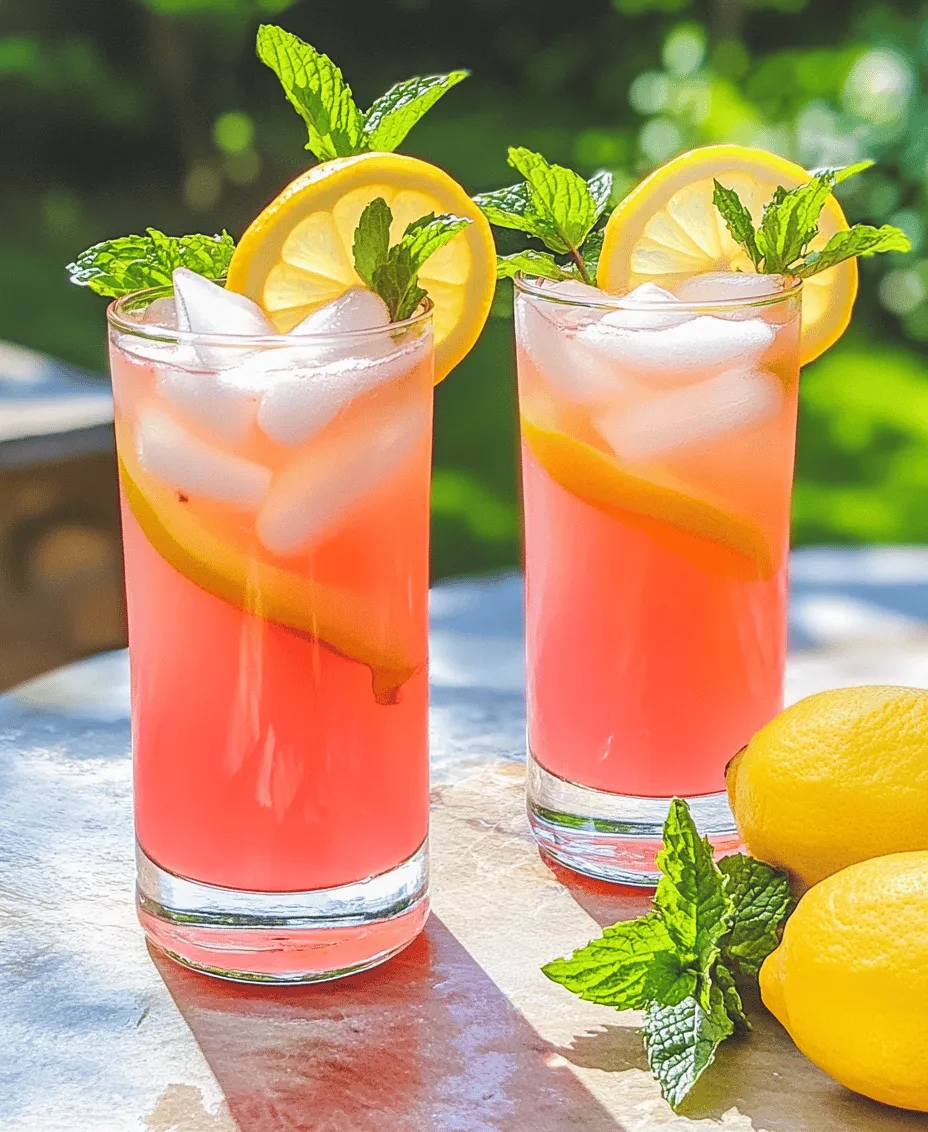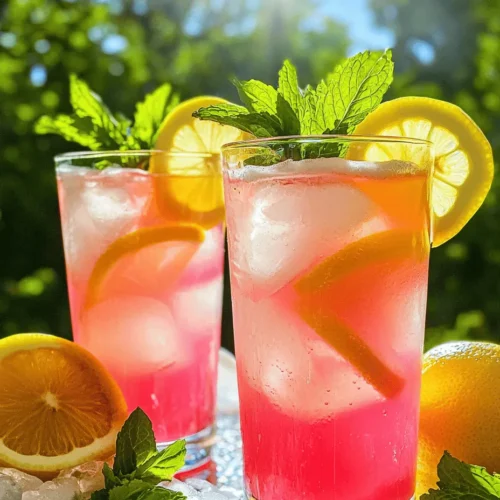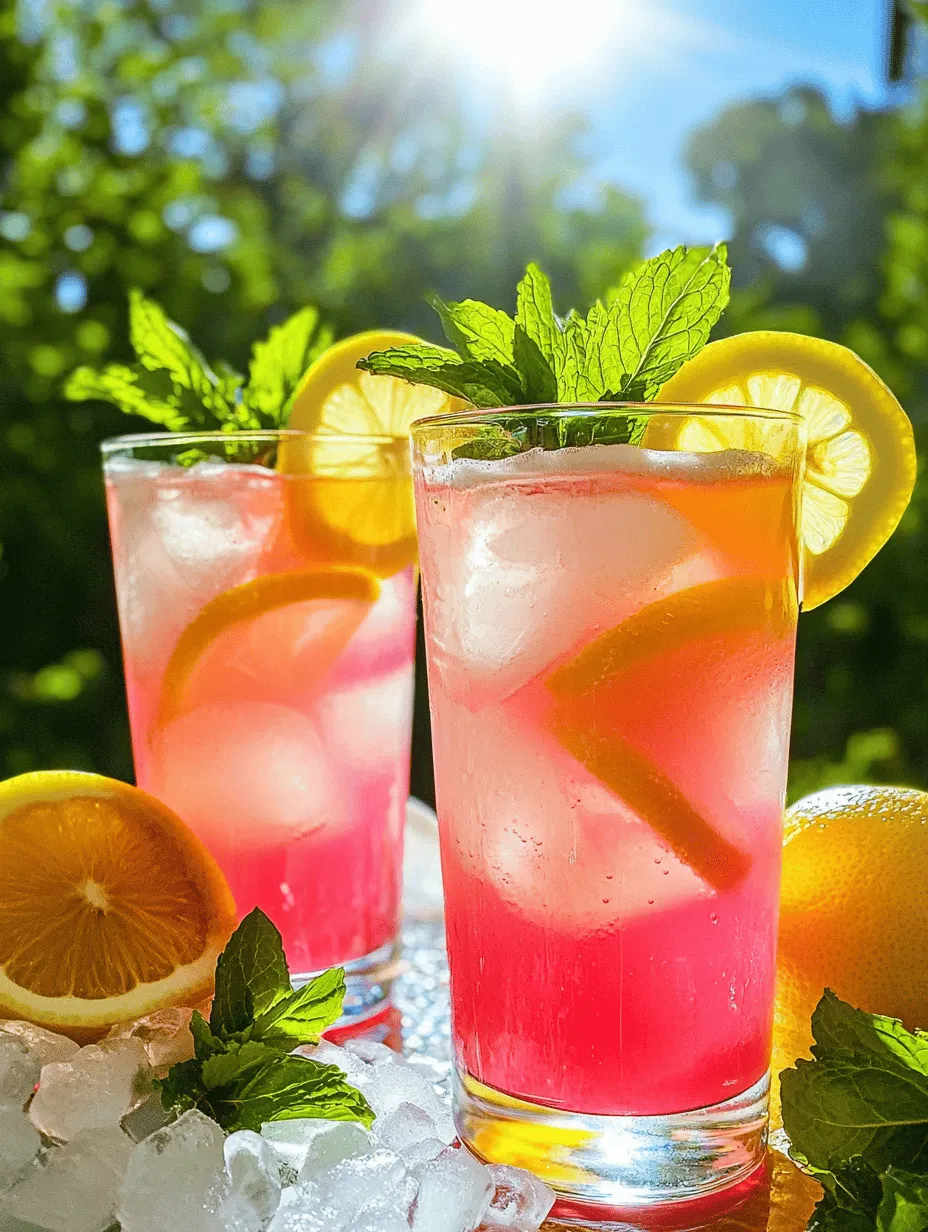Introduction
Rhubarb, often overlooked as a culinary ingredient, has gained popularity in recent years for its unique tartness and vibrant color. While traditionally celebrated in desserts like pies and crumbles, rhubarb’s versatility extends to beverages, making it a delightful addition to homemade drinks. One of the most refreshing ways to showcase this unique ingredient is through a glass of rhubarb lemonade. This sweet and tangy drink is not only invigorating but also perfect for warm weather gatherings or simply enjoying on your patio during a sunny afternoon.
Homemade drinks have a charm that store-bought versions often lack. When you make your own lemonade, you can control every aspect—from the sweetness to the intensity of flavors. With fresh ingredients at your disposal, the resulting beverage is not only more flavorful but also healthier, free from preservatives and artificial additives. As the weather warms up, there’s no better time to experiment with this refreshing rhubarb lemonade recipe that promises to quench your thirst and tantalize your taste buds.
Understanding Rhubarb
Rhubarb is a perennial plant belonging to the Polygonaceae family, closely related to sorrel and buckwheat. Its long, celery-like stalks are the edible part of the plant, while the leaves are toxic and should never be consumed. The flavor profile of rhubarb is notably tart, similar to that of cranberries, which makes it an excellent component for balancing sweetness in various recipes. When cooked, rhubarb softens and its tartness mellows, resulting in a unique taste experience that can elevate both sweet and savory dishes.
Beyond its distinctive flavor, rhubarb boasts a range of nutritional benefits. It is low in calories, high in fiber, and packed with vitamins C and K, as well as several antioxidants. These properties contribute to overall health, supporting everything from digestion to bone health. As such, incorporating rhubarb into your diet, whether through desserts or refreshing drinks, is a great way to enjoy its benefits while indulging in delicious flavors.
While rhubarb is often associated with sweet dishes, its culinary uses extend far beyond desserts. In recent years, culinary enthusiasts have discovered its potential in beverages, such as cocktails, teas, and, of course, lemonade. The tartness of rhubarb harmonizes beautifully with the acidity of lemons, creating a refreshing drink that is both pleasing to the palate and visually striking.
The Appeal of Homemade Lemonade
When it comes to lemonade, the debate between homemade and store-bought is a familiar one. While store-bought lemonade can be convenient, it often falls short in terms of flavor and freshness. Many commercial lemonades contain artificial flavors, high fructose corn syrup, and preservatives, which can detract from the natural zing of freshly squeezed lemons. In contrast, homemade lemonade allows you to harness the full essence of the ingredients, ensuring a pure and invigorating experience.
One of the primary benefits of making lemonade at home is the ability to control the ingredients. This means you can adjust the sweetness to your liking, incorporate unique flavors like rhubarb, and even experiment with different herbs and spices. Additionally, making lemonade from scratch allows you to use seasonal ingredients, making the most of the bounty of fresh produce available throughout the year. For those who love to experiment in the kitchen, this is an exciting opportunity to create a signature drink that can impress friends and family.
With its vibrant pink hue and refreshing taste, rhubarb lemonade is perfect for summer picnics, backyard barbecues, or simply enjoying on a hot day. The combination of sweet and tart flavors makes it a crowd-pleaser, appealing to both adults and children alike. As we delve into the ingredients and the process of making this delightful beverage, you’ll discover that crafting your own rhubarb lemonade is not only easy but a rewarding experience.
Ingredients Breakdown
To create the perfect refreshing rhubarb lemonade, it is essential to gather high-quality ingredients. Here’s a breakdown of what you’ll need, along with tips for selecting and storing each component.
Fresh Rhubarb
When shopping for rhubarb, look for firm, crisp stalks that are vibrant in color. The stalks should be free from blemishes or soft spots. Rhubarb can be stored in the refrigerator for up to a week, wrapped in a damp paper towel and placed in a plastic bag to retain moisture. If you find yourself with excess rhubarb, consider freezing it for later use. Simply wash, chop, and blanch the stalks before placing them in freezer bags.
Granulated Sugar
Sugar plays a crucial role in balancing the tartness of rhubarb and lemons. While granulated sugar is commonly used in this recipe, you can explore alternatives such as honey, agave syrup, or stevia. Each sweetener will impart a slightly different flavor to the lemonade, so feel free to experiment with what suits your taste best. Keep in mind that some alternatives may require different quantities to achieve the desired sweetness.
Freshly Squeezed Lemon Juice
The quality of your lemonade hinges on the freshness of your lemon juice. Opt for organic lemons when possible, as they are typically more flavorful and free from waxy coatings. To juice lemons effectively, roll them on the countertop to soften them before cutting them in half. This will help release more juice. Using freshly squeezed lemon juice will give your rhubarb lemonade a bright, zesty flavor that store-bought lemon juice simply cannot match.
Water
Water is the foundation of any beverage, including lemonade. The quality of water can significantly impact the taste of your drink. If your tap water has a strong flavor, consider using filtered or bottled water for the best results. Additionally, using cold water when making your lemonade will help maintain its refreshing qualities, especially on hot days.
Optional Ingredients
To enhance the flavor of your rhubarb lemonade, consider adding a pinch of salt to balance the sweetness and acidity. Salt can elevate the overall taste, making the flavors pop. Furthermore, garnishing your drink with fresh mint leaves, lemon slices, or even additional rhubarb stalks can provide a stunning presentation and an aromatic experience.
Step-by-Step Instructions for Refreshing Rhubarb Lemonade
Now that you have gathered all your ingredients, it’s time to dive into the process of making refreshing rhubarb lemonade. The first step involves creating a rhubarb syrup, which serves as the base for your lemonade and infuses it with that signature tart flavor.
Making the Rhubarb Syrup
1. Chop the Rhubarb: Begin by washing the rhubarb stalks thoroughly and chopping them into small pieces, about an inch long. This will help release their juices more effectively during the cooking process.
2. Combine Ingredients: In a medium saucepan, combine the chopped rhubarb, granulated sugar, and water. The typical ratio is about 2 cups of chopped rhubarb, 1 cup of sugar, and 2 cups of water, but feel free to adjust the sugar to suit your taste.
3. Heat the Mixture: Place the saucepan over medium heat and stir the mixture gently. Allow it to come to a simmer, which will help dissolve the sugar and extract the flavors from the rhubarb. Keep an eye on it to prevent boiling over.
4. Cook Until Tender: Let the mixture simmer for about 10 to 15 minutes, or until the rhubarb becomes soft and mushy. You’ll notice the syrup turning a beautiful pink color as the rhubarb releases its juices.
5. Strain the Syrup: Once the rhubarb is tender, remove the saucepan from heat. Using a fine-mesh strainer or cheesecloth, strain the syrup into a clean container, discarding the solid rhubarb pieces. This syrup can be stored in the refrigerator for up to a week, making it a convenient base for future lemonade.
6. Mix with Lemon Juice: To finish off your lemonade, combine the rhubarb syrup with freshly squeezed lemon juice and cold water. For every cup of rhubarb syrup, add about 1 cup of lemon juice and 3 to 4 cups of cold water, adjusting to taste. Stir well to combine.
Importance of Temperature and Timing
The temperature at which you serve your rhubarb lemonade is crucial. Chilling your drink before serving ensures that it is refreshing and satisfying. Consider serving it over ice for an extra cool treat on a hot day. Timing is also important when it comes to preparation. Make the rhubarb syrup in advance so that it has time to cool before mixing it with the lemon juice and water. This way, you can enjoy your lemonade immediately without the need to wait for it to chill.
With these steps, you are well on your way to crafting a delicious and refreshing rhubarb lemonade that will surely impress your family and friends. The combination of tart and sweet flavors, along with the vibrant color, makes this drink a perfect addition to any summer gathering or a delightful way to cool off on a warm day. Stay tuned for the final touches and serving suggestions in the next part of the article!

Tips for Achieving the Right Consistency and Flavor
Creating the perfect rhubarb lemonade involves more than just mixing ingredients; it requires attention to detail in terms of consistency and flavor. Here are some essential tips to help you master your rhubarb lemonade:
1. Use Fresh Ingredients: The quality of your rhubarb and lemons directly affects the taste. Fresh, vibrant rhubarb stalks and ripe lemons will yield the best flavor. Avoid any yellowing or overly fibrous rhubarb, as it can impart a less desirable taste to your drink.
2. Adjust Water Ratios: After making your syrup, taste it before diluting with water. If the syrup is too strong, gradually add more water until you achieve your desired flavor balance. Remember, you can always add more water, but it’s tough to fix an overly diluted drink.
3. Sweetness Level: If you’re looking for a sweeter lemonade, consider adding more sugar to the syrup or opting for a simple syrup made with less sugar than water for a lighter touch. Conversely, if you prefer a more tart flavor, reduce the sugar or add more lemon juice.
Straining the Syrup: Techniques for Ensuring a Smooth Finish
Straining your syrup is a crucial step to achieving a smooth, refined lemonade. Here are some techniques and equipment suggestions:
Equipment Needed for Straining
– Fine Mesh Strainer: A fine mesh strainer or sieve is ideal for removing solids from your syrup. It allows the liquid to pass through while trapping any pulp or fibrous bits.
– Cheesecloth or Nut Milk Bag: For an even finer strain, especially if your syrup has significant pulp, consider using cheesecloth or a nut milk bag. These materials capture smaller particles more effectively.
Importance of Discarding Solids for a Clean Drink
Straining out the solids is essential for a clean and enjoyable beverage. Leaving pulp or fibrous pieces in the lemonade can affect the texture and mouthfeel, detracting from the overall drinking experience. Discarding these solids ensures that each sip is smooth and refreshing.
Combining Ingredients: Balancing Flavors for Personal Preferences
Once your syrup is strained, it’s time to combine it with water and adjust the flavors to your liking. Here are some additional tips:
1. Taste as You Go: This is perhaps the most critical step. After combining the syrup with water, taste the lemonade. If it’s too sweet, add a little more lemon juice; if it’s too tart, add more syrup. This step allows you to tailor the drink to your preferences.
2. Adjusting Sweetness and Acidity: If you find the lemonade too acidic, consider adding a pinch of salt. Salt can enhance sweetness and balance acidity without making the drink salty. This is a great trick for creating a more well-rounded beverage.
3. Experiment with Flavors: Don’t hesitate to add other flavors that complement the rhubarb and lemon. Fresh herbs like mint or basil can elevate the drink further, creating a unique twist that excites the palate.
Chilling and Serving: Best Practices for Optimal Enjoyment
Proper chilling enhances the flavor and refreshment of your lemonade. Here’s how to ensure it’s served at its best:
1. Refrigerate the Lemonade: After mixing the syrup and water, allow the lemonade to chill in the refrigerator for at least 30 minutes. This cooling time helps the flavors meld beautifully.
2. Serving Suggestions: Serve your rhubarb lemonade in tall glasses filled with ice for a refreshing treat. To elevate the presentation, consider using stylish glassware. Mason jars, vintage glasses, or clear tumblers work well, allowing the beautiful pink hue of the drink to shine.
3. Garnish for Flair: Add a slice of lemon or a sprig of mint to each glass to enhance presentation and add an aromatic element. You could also float a few fresh raspberries or strawberries in the drink for a colorful touch.
Flavor Profile and Variations
Analysis of the Flavor Profile
Rhubarb lemonade boasts a delightful balance of sweetness and tartness. The natural tartness of rhubarb, complemented by the zesty brightness of lemons, creates a refreshing drink that is perfect for hot days. The sweetness from sugar rounds out the sharp flavors, making it an enticing option.
Creative Variations to the Basic Recipe
If you want to shake things up, consider these fun variations:
– Ginger Infusion: Add fresh ginger to the rhubarb while simmering the syrup for a spicy kick. Ginger adds warmth and complexity, enhancing the lemonade’s overall flavor.
– Berry Bliss: Incorporate fresh berries like strawberries, blueberries, or raspberries. You can mash them into the syrup or add them whole to the final drink for added flavor and a pop of color.
– Herbal Wonders: Infuse your syrup with herbs like basil or mint. Simply add a handful of fresh leaves to the mixture while simmering. This will create a refreshing herbal note that pairs beautifully with the tartness of rhubarb and lemon.
Alcoholic Variations for Adult Beverages
For a delightful adult twist, consider turning your rhubarb lemonade into a refreshing cocktail:
– Rhubarb Gin Fizz: Mix your rhubarb lemonade with gin and top it off with club soda for a bubbly, refreshing drink. The botanicals in gin complement the tartness of rhubarb perfectly.
– Rhubarb Mojito: Use rhubarb lemonade as a base for a mojito. Combine it with white rum, fresh mint, and a splash of soda for a delightful summer cocktail.
Nutritional Information
Understanding the nutritional profile of your homemade rhubarb lemonade is essential, especially if you’re conscious of dietary needs.
– Calories and Nutrients: A typical serving of rhubarb lemonade (1 cup) contains approximately 100 calories. This may vary depending on the amount of sugar used. The rhubarb and lemon contribute vitamins C and K, along with dietary fiber.
– Health Considerations for Sugar Intake: While sugar enhances flavor, it’s essential to monitor your intake. Opting for lower sugar alternatives like honey or agave syrup can provide a healthier option without sacrificing taste.
– Benefits of Rhubarb and Lemon in a Balanced Diet: Both rhubarb and lemon are rich in antioxidants and vitamins. Rhubarb is known for its anti-inflammatory properties and high fiber content, while lemons are famous for boosting the immune system and aiding digestion.
Conclusion
Rhubarb lemonade is a refreshing and versatile beverage that can be enjoyed in many ways. Its unique blend of tartness and sweetness makes it an ideal drink for warm days, while the potential variations allow for endless creativity in the kitchen. By experimenting with flavors and adjusting the sweetness and acidity to your liking, you can create a personalized drink that delights your taste buds.
Don’t hesitate to enjoy the process of making this delightful beverage from scratch. The satisfaction of crafting your own refreshing drink is unmatched, and nothing compares to the taste of homemade lemonade. Whether you enjoy it on a sunny afternoon or serve it at gatherings, rhubarb lemonade is sure to impress your guests and provide a truly refreshing experience. So gather your ingredients, unleash your creativity, and enjoy the delightful world of homemade beverages!



